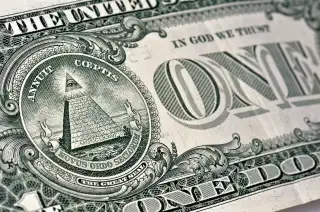10 Things You Didn't Know About the $1 Bill

While most countries don't bother with paper denominations smaller than a five, the $1 bill is the pride of America. Maybe it's the distinctive smell of that cotton-linen blend. Maybe it's because we suspect there's map to some secret treasure encoded in the design. Or maybe a thick wad of bills just makes us feel wealthier than we really are.
Whatever the reason, we clearly can't get enough of them. But how much do we really know about our National Treasure? Here are 10 things you probably didn't know about the dollar bill.
1. The average $1 bill circulates for 5.8 years.
Probably because it lasts less than a few hours in a pocket. There’s only so much abuse a piece of cotton can take, so the dollar represents 45% of bill production. For a comparison, the $100 gets 15 years before the Federal Reserve snakes it out of circulation.
2. The latin above and below the bill's pyramid is all about American exceptionalism.
“Annuit Coeptis” means “He favors our undertaking," and “Novus ordo seclorum” means “New order of the ages.” People took the Manifest Destiny thing very, very seriously, apparently.
3. There were 11.4 billion $1 bills in circulation in 2015.
Obviously, they were worth $11.4 billion. It's the most common bill, but the $100 is right behind it, with 10.8 million notes floating around.
4. The $1 bill has powerful enemies.
Republican Senator John McCain and former Democratic Senator Tom Harkin introduced a bill in 2012 that sought to replace the bill with dollar coins. Supporters say the move could save $13.8 billion over the next 30 years, but few people want to give up their paper dollars.
5. It has the oldest design of any bill in circulation.
The $1 bill has—by far—the worst return on investment of any bill you can counterfeit, so it's not a huge problem for the Federal Reserve and Bureau of Engraving. No new countermeasures mean its design hasn't really needed to change since 1963.
6. George wasn’t the only Washington on the $1 bill.
His wife Martha graced it in 1886!
7. The $1 is the only bill the Bureau of Engraving experiments with.
From 1992 to 1996, the Bureau tried “web printing,” a cheaper method that uses one continuous roll of cotton paper, enabling printing that is more than twice as fast. The agency stopped the process, but the money is still legal tender--and very valuable if you have one. These bills say either Series 1988A, Series 1993 or Series 1995 and can be identified by a little number to the right of “Trust” in the motto.
8. The $1 bill is the cheapest note to produce, at 4.9 cents per note.
No new design research and development mean low prices.
9. The pyramid has 13 steps, for the original colonies and is unfinished.
This was to show our country can constantly be improved, and to make room for the “Eye of Providence,” which represents an all-seeing god.
10. Salmon P. Chase was the first person on the $1, in 1863.
Not only was he alive at the time, he was the incumbent secretary of the Treasury, so he put himself on the bill. Chase's magnificent hubris ended in 1869 when George Washington bumped him off the bill in a redesign.